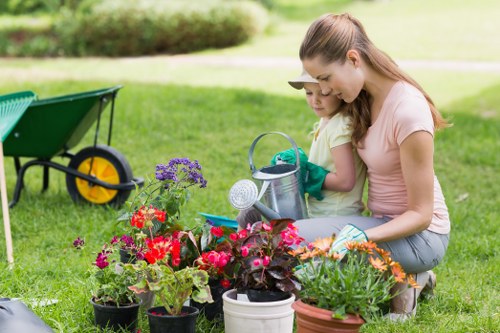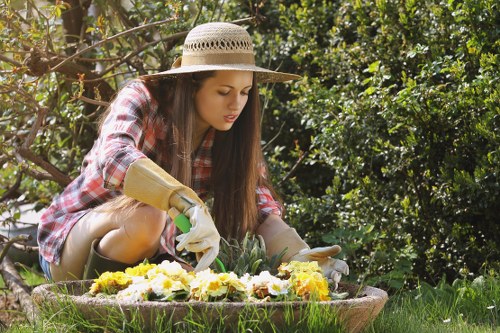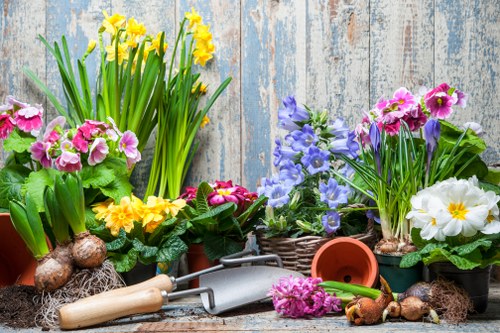Landscape Gardening in Whitechapel

Whitechapel, a vibrant and historically rich area of London, offers a unique canvas for landscape gardening enthusiasts. Whether you're a homeowner looking to beautify your garden or a business aiming to create an inviting outdoor space, landscape gardening in Whitechapel provides endless opportunities to transform any area into a stunning oasis.
With its blend of urban charm and green spaces, Whitechapel is the perfect setting for innovative gardening designs. The area's diverse community and rich cultural heritage inspire gardeners to incorporate a variety of plants, styles, and elements that reflect the spirit of the neighborhood.
Understanding the local climate and soil conditions is essential for successful landscape gardening in Whitechapel. The region experiences a temperate maritime climate, which allows for a wide range of plant species to thrive. Choosing the right plants and materials can ensure your garden remains beautiful and sustainable throughout the year.

The Importance of Landscape Gardening
Landscape gardening goes beyond mere aesthetics; it plays a crucial role in enhancing the environmental quality and livability of Whitechapel. Well-designed gardens can improve air quality, reduce noise pollution, and provide habitats for local wildlife, contributing to the overall ecological balance of the area.
In addition to environmental benefits, landscape gardens offer significant social and psychological advantages. Green spaces serve as communal areas where residents can relax, socialize, and engage in recreational activities, fostering a sense of community and well-being.
Moreover, attractive landscapes can increase property values and make neighborhoods more appealing to potential residents and businesses. Investing in landscape gardening is not only beneficial for individual property owners but also for the broader community of Whitechapel.

Planning Your Landscape Garden
Effective landscape gardening in Whitechapel begins with careful planning. Assessing your space, understanding your needs, and setting clear objectives are fundamental steps in creating a garden that aligns with your vision and lifestyle.
Start by evaluating the size and layout of your outdoor area. Consider factors such as sunlight exposure, soil quality, existing structures, and drainage patterns. These elements will influence your plant selection, garden layout, and overall design strategy.
Next, identify the primary functions of your garden. Do you want a space for entertaining, a peaceful retreat, or a child-friendly play area? Defining the purpose of your garden will help guide your design choices and ensure that the final result meets your expectations.

Choosing the Right Plants
Selecting appropriate plants is a cornerstone of successful landscape gardening in Whitechapel. The local climate supports a diverse array of plant species, allowing gardeners to experiment with different textures, colors, and forms.
Perennials vs. Annuals
Perennial plants offer lasting beauty as they return year after year, reducing the need for frequent replanting. Popular choices in Whitechapel include lavender, hostas, and ornamental grasses. Annuals, on the other hand, provide vibrant seasonal color but require more maintenance.
Native Plants
Incorporating native plants into your garden can enhance its sustainability and reduce maintenance efforts. Native species are well-adapted to the local environment, making them more resilient to pests and diseases.

Design Elements and Features
Integrating various design elements can elevate the aesthetic appeal and functionality of your landscape garden. From water features to lighting, each element contributes to the overall ambiance and usability of the space.
Water Features
A well-placed water feature, such as a fountain or pond, can serve as a focal point in your garden. The sound of running water adds a soothing element, enhancing the tranquility of the environment.
Pathways and Walkways
Pathways not only guide visitors through your garden but also add structure and visual interest. Materials like stone, gravel, and wood can create different moods and complement your garden's style.
Garden Lighting
Strategic lighting can extend the usability of your garden into the evening hours. It highlights key features, ensures safety, and creates a magical atmosphere under the night sky.

Seasonal Garden Maintenance
Maintaining your landscape garden throughout the year is essential to keep it looking its best. Regular upkeep ensures that plants remain healthy and that the garden continues to thrive through all seasons.
- Spring: Focus on planting new seeds, pruning overgrown shrubs, and preparing the soil for the growing season.
- Summer: Ensure consistent watering, manage pests, and enjoy the full bloom of your garden.
- Autumn: Clean up fallen leaves, plant bulbs for spring, and protect sensitive plants from the cold.
- Winter: Conduct structural maintenance, plan for the next year, and protect perennials from frost.
Implementing a seasonal maintenance schedule can help you stay organized and ensure that your landscape garden remains beautiful and healthy year-round.
Regular maintenance tasks, such as weeding, mulching, and fertilizing, are crucial for sustaining the vitality of your garden. Investing time and effort into these activities will pay off with a lush and vibrant outdoor space.
Additionally, seasonal tasks like pruning and deadheading can promote plant health and encourage more vigorous blooming, enhancing the overall appearance of your garden.

Sustainable Gardening Practices
Adopting sustainable gardening practices not only benefits the environment but also contributes to the long-term success of your landscape garden in Whitechapel. Eco-friendly techniques help conserve resources and create a harmonious balance with nature.
Water Conservation
Implementing water-saving measures, such as rainwater harvesting and drip irrigation, can significantly reduce water usage. These methods ensure that your plants receive the necessary moisture without wastage.
Composting
Creating a compost pile allows you to recycle organic waste into nutrient-rich soil amendments. Composting improves soil structure, enhances fertility, and reduces the need for chemical fertilizers.
Native and Drought-Tolerant Plants
Incorporating native and drought-tolerant plants into your garden reduces the reliance on irrigation and sustains the local ecosystem. These plants are adapted to the region's climate and require minimal maintenance.

Incorporating Hardscaping Elements
Hardscaping elements, such as patios, decks, and fences, add structure and functionality to your landscape garden. These features complement the softscape elements and enhance the overall design.
Patio and Deck Design
A well-designed patio or deck provides a space for outdoor entertaining and relaxation. Choosing the right materials, such as natural stone or composite decking, can elevate the aesthetic appeal and durability of these structures.
Fencing and Boundaries
Fencing defines the boundaries of your garden and offers privacy from neighboring properties. Options range from classic wooden fences to modern metal designs, allowing you to customize the look to suit your style.
- Privacy Fencing: Ideal for creating secluded areas within your garden.
- Decorative Fencing: Adds visual interest and enhances the garden's aesthetic.
- Functional Fencing: Provides security and delineates different garden zones.

Integrating Outdoor Living Spaces
Outdoor living spaces extend the functionality of your landscape garden, providing areas for dining, lounging, and recreation. These spaces bridge the gap between indoor and outdoor environments, enhancing your lifestyle.
Outdoor Kitchens and Dining Areas
Installing an outdoor kitchen or dining area allows you to enjoy meals al fresco, making your garden a hub for social gatherings and family interactions. Features like grills, countertops, and seating arrangements make these spaces inviting and practical.
Fire Pits and Heaters
Fire pits and outdoor heaters create a warm and cozy atmosphere, enabling you to enjoy your garden even during cooler evenings. These elements add both functionality and ambiance to your outdoor space.
Seating and Relaxation Areas
Comfortable seating options, such as benches, lounge chairs, and hammocks, provide areas for relaxation and contemplation. Thoughtfully arranged seating zones encourage you to spend more time enjoying your garden.

Professional Services for Landscape Gardening
Engaging professional landscape gardeners can enhance the quality and efficiency of your garden project in Whitechapel. Experts bring valuable knowledge, experience, and resources to create and maintain stunning outdoor spaces.
Custom Garden Design
Professional designers work with you to develop tailored garden plans that reflect your preferences and meet your specific needs. Their expertise ensures that every aspect of the garden, from plant selection to layout, is thoughtfully considered.
Installation and Maintenance
Experts handle the installation of plants, hardscaping elements, and other features, ensuring high-quality workmanship and timely completion. Ongoing maintenance services keep your garden in optimal condition, saving you time and effort.
Consultation and Advice
Professional landscapers provide valuable insights and recommendations on best practices, sustainable gardening techniques, and innovative design ideas. Their guidance helps you make informed decisions and achieve your garden goals.

Budgeting for Your Garden Project
Creating a beautiful landscape garden in Whitechapel requires careful budgeting and resource allocation. Planning your finances ensures that your project is completed without unexpected costs or compromises.
- Initial Planning: Outline your garden design, list desired features, and prioritize elements based on importance and budget.
- Cost Estimates: Obtain quotes from suppliers and contractors to estimate the costs of materials, labor, and services.
- Contingency Funds: Set aside a portion of your budget for unforeseen expenses or changes in the project scope.
- Phased Implementation: Consider completing the project in stages to spread out costs and manage the budget effectively.
By carefully planning and budgeting, you can achieve your landscape gardening vision in Whitechapel without financial stress.
Additionally, exploring cost-effective options and prioritizing essential elements can help maximize your budget and create a stunning garden within your financial constraints.
Investing in quality materials and professional services can provide long-term savings by reducing maintenance costs and ensuring the durability of your garden features.

Enhancing Biodiversity in Your Garden
Promoting biodiversity in your landscape garden contributes to a healthy and resilient ecosystem. Diverse plant species attract various pollinators, birds, and beneficial insects, enhancing the overall vitality of your garden.
Pollinator-Friendly Plants
Incorporate plants that attract bees, butterflies, and other pollinators. Species like lavender, salvia, and monarch milkweed provide essential resources for these beneficial creatures.
Habitat Creation
Creating habitats for wildlife includes adding birdhouses, insect hotels, and water sources. These features support a diverse range of species, fostering a balanced and thriving garden environment.
Companion Planting
Companion planting involves growing compatible plants together to enhance growth, deter pests, and improve overall garden health. This technique promotes natural pest control and reduces the need for chemical interventions.

Trends in Landscape Gardening
Staying updated with the latest trends in landscape gardening can inspire innovative designs and ensure your garden remains modern and appealing. Current trends emphasize sustainability, resilience, and aesthetic versatility.
Edible Gardens
Integrating edible plants like vegetables, herbs, and fruit trees into your landscape garden combines beauty with functionality. Edible gardens provide fresh produce and contribute to a sustainable lifestyle.
Minimalist Design
Minimalist gardens focus on simplicity, clean lines, and uncluttered spaces. This approach emphasizes the natural beauty of selected plants and materials, creating a serene and elegant outdoor environment.
Vertical Gardening
Vertical gardening maximizes space by growing plants on walls, trellises, and other vertical structures. This trend is particularly beneficial for urban gardens with limited ground space.

Community Gardens and Urban Green Spaces
Community gardens and urban green spaces play a vital role in enhancing the environmental and social fabric of Whitechapel. These shared spaces provide opportunities for residents to engage in gardening, foster community spirit, and promote environmental stewardship.
Benefits of Community Gardens
Community gardens offer numerous benefits, including access to fresh produce, educational opportunities, and spaces for social interaction. They also contribute to the beautification and sustainability of urban areas.
Creating Shared Spaces
Designing community gardens requires thoughtful planning to accommodate diverse needs and preferences. Providing common areas, individual plots, and shared facilities ensures that the garden serves as a welcoming and inclusive space for all.
Promoting Sustainability
Community gardens can serve as models for sustainable practices, showcasing techniques like composting, rainwater harvesting, and organic gardening. These initiatives inspire participants to adopt eco-friendly habits in their personal gardens.

Tools and Equipment for Landscape Gardening
Having the right tools and equipment is essential for efficient and effective landscape gardening. Proper tools not only make gardening tasks easier but also contribute to the quality of your garden's maintenance.
Basic Gardening Tools
Essential tools for any gardener include:
- Hand Trowel: Ideal for planting, transplanting, and digging small holes.
- Pruning Shears: Perfect for trimming and shaping plants.
- Garden Fork: Useful for turning soil and aerating garden beds.
- Rake: Essential for leveling soil and removing debris.
Advanced Equipment
For more extensive gardening projects, consider investing in advanced equipment such as:
- Lawn Mower: Keeps your lawn neat and well-maintained.
- Hedge Trimmers: Facilitates precise trimming of hedges and shrubs.
- Wheelbarrow: Aids in transporting soil, plants, and other materials with ease.
- Irrigation Systems: Automates watering, ensuring consistent moisture levels for your plants.
Choosing the right tools and maintaining them properly can enhance your gardening efficiency and the overall health of your landscape garden.

Seasonal Planting Tips
Effective seasonal planting is key to maintaining a vibrant and resilient landscape garden in Whitechapel. Each season presents unique challenges and opportunities, requiring specific planting strategies.
Spring Planting
Spring is an ideal time for planting a wide variety of flowers, shrubs, and trees. The mild weather and increased daylight encourage strong growth and establishment of new plants.
Summer Care
During the summer, focus on maintaining adequate moisture levels and providing shade for delicate plants. Regular monitoring for pests and diseases is also crucial to prevent infestations.
Autumn Preparation
Autumn is the season for preparing your garden for winter. Planting bulbs, mulching, and pruning help protect plants from the cold and set the stage for a thriving garden in the spring.

Lighting Your Landscape Garden
Effective lighting enhances the beauty and safety of your landscape garden, allowing you to enjoy the space during evening hours. Thoughtfully placed lights highlight key features and create an inviting ambiance.
Types of Outdoor Lighting
Common types of outdoor lighting include:
- Path Lights: Illuminate walkways, ensuring safe navigation through your garden.
- Spotlights: Highlight specific features such as statues, trees, or water elements.
- String Lights: Add a festive and charming atmosphere to outdoor seating areas.
- Solar Lights: Eco-friendly options that harness solar energy for illumination.
Energy-Efficient Solutions
Choosing energy-efficient lighting options, such as LED bulbs and solar-powered fixtures, reduces energy consumption and lowers utility costs. These solutions also contribute to a more sustainable garden environment.
Maintenance Tips
Regular maintenance of your outdoor lighting ensures optimal performance and longevity. Clean fixtures, replace burnt-out bulbs, and adjust light angles to maintain the desired effect.

Creating Privacy in Your Garden
Privacy is an important aspect of landscape gardening, especially in urban areas like Whitechapel. Creating secluded areas within your garden allows you to enjoy a personal retreat away from the hustle and bustle of city life.
Natural Barriers
Using plants as natural barriers is an effective way to enhance privacy. Dense hedges, tall shrubs, and flowering vines can create green walls that block unwanted views while adding beauty to your garden.
Architectural Features
Incorporating architectural elements such as pergolas, fences, and walls can provide additional privacy and structure to your garden. These features can be decorated with climbing plants or adorned with decorative panels for enhanced visual appeal.
Strategic Layout
Positioning seating areas and garden features strategically can maximize privacy. Placing these elements in secluded corners or behind natural barriers ensures a more intimate and private garden experience.

Using Color in Landscape Gardening
Color plays a pivotal role in the aesthetic appeal of your landscape garden. Thoughtful color schemes can create harmony, contrast, and visual interest, transforming your garden into a vibrant and inviting space.
Choosing a Color Palette
Selecting a cohesive color palette helps unify different elements of your garden. Consider the colors of your plants, hardscaping materials, and decorative features to create a balanced and pleasing visual composition.
Seasonal Color Coordination
Incorporate plants that bloom in different seasons to ensure continuous color throughout the year. Combining spring blossoms, summer flowers, autumn hues, and winter interest creates a dynamic and ever-changing garden landscape.
Accent Colors
Using accent colors strategically can highlight specific areas or features in your garden. Bold colors in focal points draw attention, while softer tones can create a sense of calm and serenity.

Personalizing Your Garden
Personalizing your landscape garden infuses your unique personality and style into the space. Custom touches make your garden a true reflection of your tastes and preferences, enhancing your connection to the environment.
Decorative Elements
Incorporate decorative elements such as sculptures, garden art, and unique planters to add character and charm to your garden. These features can serve as conversation starters and showcase your creative side.
Themed Gardens
Creating themed gardens, such as a Japanese Zen garden, a Mediterranean oasis, or a cottage-style garden, allows you to explore different aesthetics and design philosophies. Themes provide a cohesive framework for your garden's layout and plant selection.
Personal Mementos
Including personal mementos like family photos, handmade ornaments, or sentimental objects adds a heartfelt touch to your garden. These items make the space uniquely yours and enhance the emotional connection to your outdoor area.

Choosing the Right Garden Furniture
Garden furniture complements your landscape design and provides functional spaces for relaxation and entertainment. Selecting the right furniture enhances the comfort and usability of your garden.
Materials and Styles
Choose garden furniture made from durable materials such as teak, metal, or weather-resistant wicker. The style of the furniture should align with your overall garden design, whether it be modern, traditional, or eclectic.
Seating Arrangements
Arrange seating in a way that promotes conversation and enjoyment of the garden's beauty. Consider options like benches, lounge chairs, and outdoor sofas to create inviting gathering spots.
Storage Solutions
Incorporate storage solutions like garden benches with hidden compartments or storage sheds to keep your furniture and garden tools organized and protected from the elements.

Vertical Gardening Techniques
Vertical gardening is an innovative way to maximize space and add visual interest to your landscape garden, especially in urban settings like Whitechapel where space may be limited.
Living Walls
Living walls, or green walls, are vertical structures covered with plants. They can be installed indoors or outdoors, providing a stunning backdrop and improving air quality.
Vertical Planters
Vertical planters come in various forms, including pocket planters, trellises, and hanging pots. These structures allow you to grow herbs, flowers, and even small vegetables in a compact space.
Benefits of Vertical Gardening
Vertical gardening offers numerous benefits, such as increased plant diversity, space efficiency, and enhanced aesthetic appeal. It also makes gardening accessible for those with limited ground space.

Incorporating Technology in Gardening
Integrating technology into your landscape gardening routine can enhance efficiency, precision, and overall garden health. From smart irrigation systems to garden monitoring tools, technology offers numerous advantages for modern gardeners.
Smart Irrigation Systems
Smart irrigation systems automate watering schedules based on weather conditions and soil moisture levels. These systems conserve water and ensure your plants receive the optimal amount of moisture.
Garden Monitoring Tools
Use garden monitoring tools like soil sensors, weather stations, and plant health trackers to gather data and make informed decisions about your garden care practices.
Automation and Robotics
Automated tools and robotic devices can assist with tasks such as mowing, pruning, and pest control, reducing manual labor and increasing precision in garden maintenance.

Framing Your Garden with Focal Points
Focal points draw attention and create a sense of direction within your landscape garden. Strategically placing these elements enhances the visual appeal and guides visitors through your garden.
Choosing a Focal Point
Select a central feature that stands out, such as a statue, a unique plant, a water feature, or an architectural element. This focal point becomes the centerpiece around which the rest of the garden is designed.
Enhancing with Surrounding Elements
Complement your focal point with surrounding plants, lighting, and pathways to create a cohesive and harmonious arrangement. These elements enhance the presence of the focal point and integrate it seamlessly into the garden's layout.
Maintaining Visual Interest
Vary the focus points throughout different areas of the garden to maintain visual interest and encourage exploration. This approach ensures that each section of the garden offers something unique and engaging.

Conclusion
Landscape gardening in Whitechapel is a rewarding endeavor that combines creativity, sustainability, and community spirit. By thoughtfully planning your garden, selecting the right plants and materials, and incorporating various design elements, you can create a beautiful and functional outdoor space that enhances your lifestyle and contributes to the vibrancy of the neighborhood.
Whether you're a seasoned gardener or just starting out, embracing the unique opportunities that Whitechapel offers can lead to a thriving and picturesque landscape garden. From sustainable practices to innovative design trends, the possibilities are endless, allowing you to craft a garden that truly reflects your vision and values.
Remember, the key to successful landscape gardening lies in continuous learning, regular maintenance, and a passion for nurturing your outdoor sanctuary. Embrace the journey and enjoy the transformative power of your landscape garden in Whitechapel.